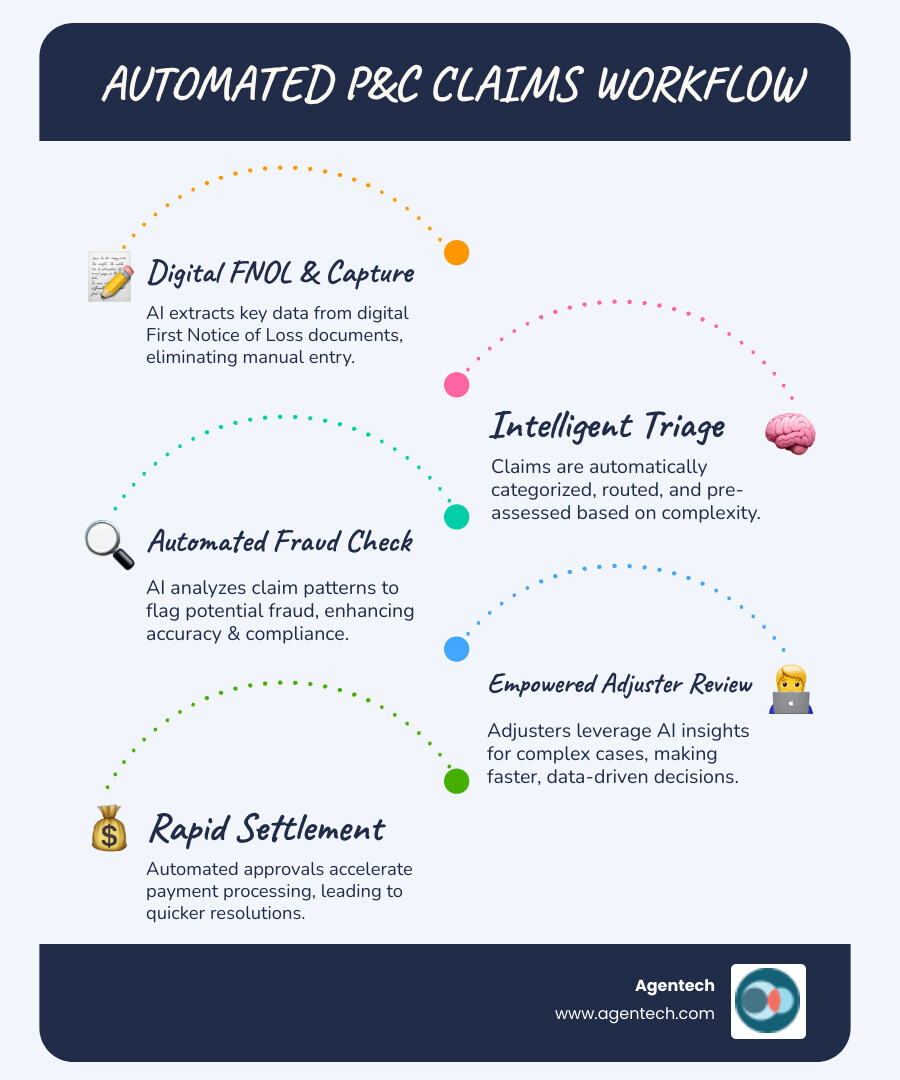Streamlining the P&C Claims Journey
Claims automation tools are changing how Property & Casualty insurance carriers, TPAs, and IA firms handle everything from first notice of loss to final settlement. Manual claims processing is expensive, slow, and prone to errors. Adjusters spend hours on administrative tasks that automation can handle in seconds.
Effective claims automation tools extract data from documents, route claims to the right adjusters, flag potential fraud, and generate reports without manual compilation. They integrate with existing policy administration systems to reduce processing time and costs.
According to McKinsey, automation can cut operating costs by up to 40 percent. Claims that once took weeks to settle can now be processed in near real time. For low complexity cases, many claims at leading insurers are settled without human intervention.
The urgency is real. Regulatory scrutiny is increasing, and the average cost of a data breach in the P&C insurance sector has reached millions. At the same time, customer expectations have shifted. Policyholders want instant updates, transparent communication, and fast payouts. Manual processes simply cannot keep pace.

I'm Alex Pezold, founder of Agentech AI, where we're building the AI workforce for P&C insurance claims processing. After successfully scaling and exiting TokenEx in 2021, I've focused on developing claims automation tools that empower adjusters rather than replace them, starting with pet insurance and expanding across residential property, auto, and workers' compensation lines.
Why P&C Insurers Are Embracing Automation
The Property & Casualty insurance industry is at a turning point. Traditional manual processes are creating bottlenecks that cost money and frustrate customers. That's why forward thinking P&C carriers, TPAs, and IA firms are turning to claims automation tools to transform how they work.
The shift is happening because the results are impossible to ignore. Insurers using automation are seeing operating costs drop significantly, according to McKinsey research. They're processing claims faster, their adjusters are more productive, and their customers are happier with the claims experience.
The pressure to automate comes from multiple directions: rising operational costs, labor shortages, and evolving customer expectations for digital service. The good news is that automation doesn't mean replacing your team. The best claims automation tools empower adjusters by handling tedious tasks so they can focus on what humans do best: judgment, empathy, and complex problem solving. Agentech's AI is designed with adjusters in mind, augmenting their capabilities rather than threatening their jobs.
Reduce Costs and Boost Efficiency
When you automate repetitive tasks in claims processing, the savings add up fast. Research shows that P&C insurers can reduce the cost of the claims journey by as much as 30 percent by simplifying and automating their workflows. For a mid sized carrier, this can translate to millions in annual savings.
These savings come from reducing manual oversight on tasks like data entry and document review. Processing times can drop by 30 to 50 percent when automation handles routine tasks. Productivity gains are equally impressive, with some reports showing increases of 50 percent or more. These are transformative changes that let you handle more claims with the same team. This efficiency also helps solve the insurance labor crisis by making existing teams more effective.
Improve Accuracy and Compliance
Errors and compliance violations are a major concern for insurance executives. A single mistake in claims processing can lead to rework, erode customer trust, and result in regulatory scrutiny. Claims automation tools virtually eliminate human error in repetitive tasks. A system extracts data and applies rules with 100 percent consistency every time.
Standardized workflows are another compliance superpower. Automated systems ensure every claim follows the same process, creating complete audit trails automatically. This allows you to prove to regulators what happened and when. Modern automation platforms also incorporate fraud detection algorithms to spot suspicious patterns that humans might miss, protecting your bottom line while ensuring legitimate claims are processed quickly. Look for platforms that meet key security and compliance standards to strengthen your security posture.
Improve the Customer and Adjuster Experience
Traditional claims processes are often slow and opaque for policyholders. Automation changes this by enabling claim submission through mobile apps, providing real-time status tracking, and delivering automated updates. As a result, payments can arrive in days instead of weeks.
This has a dramatic impact on customer satisfaction. When routine interactions are handled smoothly by automation, customers get faster service. It also makes adjusters' jobs better. By taking repetitive tasks off their plates, automation reduces the administrative burden that drives burnout. Adjusters can then focus on high value work that requires human judgment, such as complex investigations and direct customer communication.
This creates a virtuous cycle: better tools lead to happier, more productive adjusters. Happier adjusters provide better service, which creates satisfied customers who remain loyal.
Essential Features of Modern Claims Automation Tools
Choosing the right claims automation tools requires understanding which features truly matter. Based on our work with P&C insurance carriers, TPAs, and IA firms, a few core capabilities make all the difference.

| Feature Category | Description | Key Benefits for P&C Insurance |
|---|---|---|
| AI and Machine Learning | Automated fraud detection, predictive analytics, intelligent document processing. | Faster, more accurate assessments; reduced financial losses; improved decision making. |
| Integration Capabilities | Seamless connection with existing core systems, APIs, and third party tools. | Eliminates data silos; avoids manual data entry; streamlines workflows. |
| Scalability | Ability to handle growing claim volumes and evolving business needs. | Supports business growth; maintains performance during peak times; flexible deployment. |
| Security and Compliance | Robust data protection, regulatory adherence, audit trails. | Safeguards sensitive data; avoids fines; builds trust with policyholders. |
AI and Machine Learning Capabilities
AI and machine learning are the engines that power effective claims automation tools. Fraud detection is where AI shines, as it can identify suspicious claims patterns that even experienced adjusters might miss. These systems analyze thousands of data points to identify red flags and perform compliance checks.
Predictive analytics enables more accurate risk assessments and can help predict claim severity, allowing you to optimize resource allocation. Document data extraction using Natural Language Processing and Optical Character Recognition transforms how adjusters work. Instead of manually typing information, these technologies extract it from unstructured documents, images, and even handwritten notes.
The most exciting development is Agentic AI, which combines automation and generative AI to autonomously complete complex tasks. Market projections show significant growth in the AI driven P&C insurance market. At Agentech, our AI Agents are designed with adjusters in mind, boosting productivity without replacing human decision-making. We've also explored insurance claims machine learning in depth to help you understand the possibilities.
Integration with Core Systems
Your claims management software needs to work with your policy administration systems, CRMs, and other platforms. Without robust integration, even the most sophisticated automation can create new data silos and manual work.
The best claims automation tools use APIs and pre built connectors to bridge these gaps. When data flows freely across your organization, adjusters get a unified view of policyholders and claims. This means that when a claim is submitted, the information automatically populates across systems, triggers the correct workflow, and notifies the assigned adjuster, all without manual intervention.
Scalability and Secure Deployment
Your claims automation tools need to scale with you as your business grows. Scalability means the system can handle rising claim volumes and increasing operational complexity without slowing down. Cloud based deployment options typically offer the most flexibility, though some P&C insurers may prefer on premise or hybrid solutions for data residency reasons.
Security is paramount. P&C insurance companies handle highly sensitive data, making security and compliance critical. Your platform should comply with key regulations like SOC 2 and HIPAA. Essential security features include encryption, role based access controls, multi factor authentication, and advanced threat detection. Detailed audit trails are also essential for compliance reporting and proving to regulators that you are handling data responsibly.
A Roundup of Top Claims Automation Tool Categories
Navigating the landscape of claims automation tools can be daunting. To simplify your search, we've categorized the most common types of solutions that P&C insurance carriers, TPAs, and IA firms typically consider. Each category offers distinct advantages, catering to different needs and operational scales.
1. Visual Process Builders for Claims Automation
Imagine building a complex claims workflow without writing any code. That's what visual process builders offer. These claims automation tools empower your team to design and deploy automated workflows using simple drag and drop interfaces.
Visual process builders can eliminate the chaos of juggling emails and spreadsheets. No code tools enable P&C insurers to create streamlined, digital workflows. Instead of waiting for IT, a claims manager can create a new workflow in a fraction of the time.
These platforms often include pre built templates for common P&C insurance processes like first notice of loss and damage assessment. They use rules based engines to route claims to the right adjuster based on complexity, coverage type, or claim amount. Because you build compliance standards directly into the workflow, every claim follows the correct procedure automatically.
These tools are ideal for mid sized P&C carriers, TPAs, and IA firms that need departmental automation without a massive IT project. They are perfect for empowering "citizen developers"—people who understand the claims process deeply but lack programming backgrounds. When your team can build and modify solutions themselves, you can respond faster to changing business needs.
2. Intelligent Automation and AI Driven Platforms
When simple task automation isn't enough, intelligent automation platforms step in. These claims automation tools combine the speed of Robotic Process Automation (RPA) with the intelligence of AI and Machine Learning. They act as your claims team's super powered assistants.
These platforms deploy bots to tackle high volume, repetitive work like data entry and document processing. But they don't just follow simple rules; they learn and make intelligent decisions.
Intelligent document processing is a game-changer for P&C insurance claims. AI powered systems can automatically extract relevant data from police reports, medical records, and repair estimates, understanding context and even flagging inconsistencies.
These platforms also excel at detecting suspicious fraud patterns that human reviewers might miss by analyzing thousands of claims in real time. Some solutions can process claims significantly faster with built-in fraud detection capabilities. Predictive analytics can forecast claim severity and recommend optimal resource allocation.
The real power comes from end to end automation. Low complexity claims can move from first notice of loss to payment without manual intervention, freeing up your skilled adjusters for high value cases.
These platforms are ideal for large P&C carriers, organizations with complex legacy systems, and firms looking to scale operations without proportionally increasing headcount.
3. API-First Integration Platforms
In today's P&C insurance landscape, data trapped in separate systems is a major roadblock. When your policy administration system doesn't talk to your claims management software, adjusters waste time manually transferring information. API first integration platforms are essential claims automation tools that solve this problem.
These platforms act as the connective tissue between all your disparate systems, allowing legacy mainframes and modern cloud applications to communicate automatically. They are built around APIs (Application Programming Interfaces), which are sets of rules for software communication.
Their power lies in reusable APIs and pre built connectors. Instead of building custom integrations from scratch, these platforms offer ready made connectors for common P&C insurance systems. This allows you to connect your entire ecosystem without months of custom development.
For P&C carriers integrating legacy systems with modern applications, this approach is transformative. Information flows automatically from intake to payment, creating a unified view of each claim and policyholder. This accelerates digital change projects because you can keep reliable legacy systems while modernizing other parts of your tech stack.
These platforms are ideal for P&C insurers and TPAs undergoing digital change, especially those struggling with data silos. If your team is constantly switching between systems to get a complete picture of a claim, an API first integration platform provides the foundation for true end to end automation.
4. Open Source and Self Hosted Claims Automation Solutions
For P&C insurance carriers, TPAs, and IA firms with strict data residency requirements or unique security protocols, open source and self hosted claims automation tools offer a powerful alternative to cloud based solutions.
Think of these platforms as a customizable toolbox. Unlike proprietary claims software, open source solutions give you access to the underlying code. Your development team can tailor every aspect of the automation to fit your exact business needs, whether it's handling specialized workers' compensation workflows or integrating with old legacy systems.
Data security is a key advantage of self hosted solutions. When you deploy on your own infrastructure, sensitive policyholder information never leaves your servers. This is crucial for organizations in jurisdictions with strict data residency laws. You control the encryption, access protocols, and audit trails.
Flexibility extends to pricing as well. Many open source platforms offer more predictable cost structures without per user fees that can grow with claim volumes. Custom scripting capabilities mean you can build the exact integrations you need.
Scalability is another core feature. As your P&C insurance business expands, the system can grow with you without sacrificing performance. This approach requires a tech savvy team, but for organizations that want maximum control over their claims automation, open source and self hosted solutions are an ideal fit.
How to Choose the Right Claims Automation Tool for Your Business
Selecting the perfect claims automation tools for your P&C insurance operation requires a careful look at your needs, infrastructure, and goals.

Here are key steps to guide your decision:
- Assess Your Current Workflow: Before looking at tools, map your existing claims process. Identify bottlenecks, time consuming tasks, and adjuster frustrations. Pinpointing these pain points will guide you to a solution that solves your real problems.
- Prioritize Security and Compliance: This is not negotiable in P&C insurance. Any tool you consider must be SOC 2 compliant and offer robust data encryption. Look for role based access controls and detailed audit trails to ensure you meet all regulatory requirements.
- Ensure Seamless Integration: The tool must fit into your existing tech ecosystem. Look for robust API capabilities and pre built connectors for your policy administration system, CRM, and other platforms to avoid creating new data silos.
- Plan for Growth: Can the tool handle your current claim volume and scale with you? The best claims automation tools offer flexible deployment options, whether cloud based or on premise, to support your growth.
- Evaluate Ease of Use: Choose a tool that empowers your team. Low code and no code platforms allow adjusters and claims managers to build or modify workflows themselves, accelerating adoption and ensuring the solution fits their needs.
- Examine AI Capabilities: Does the platform offer intelligent document processing? Can it flag potentially fraudulent claims? Does it provide predictive analytics relevant to your lines of business?
- Start with a Pilot Project: Instead of a full scale rollout, pick a high impact area to see results quickly. Define clear, measurable goals, such as reducing processing time by a specific percentage, to evaluate success.
- Involve Your Adjusters: Your adjusters' insights are invaluable. Involving them from day one ensures their buy-in and helps shape a solution they will champion.
The decision between buying a SaaS AI technology solution versus building your own is significant. By assessing your needs and evaluating solutions against these criteria, you can choose the right claims automation tools to empower your P&C insurance operations.
Frequently Asked Questions about Claims Automation Tools
We talk to P&C insurance carriers, TPAs, and IA firms every day, and certain questions about claims automation tools come up again and again. Let's tackle the big ones.
How does automation impact claims adjusters?
Automation doesn't replace adjusters; it makes their jobs better. At Agentech, our AI assistants are designed with adjusters in mind, taking tedious work off their plates so they can focus on what matters.
Claims automation tools handle tasks like data entry and document sorting, acting as a highly efficient assistant. This reduces the administrative burden and frees adjusters from repetitive work.
With automation handling routine tasks, adjusters can dedicate more time to complex cases that need human judgment, such as fraud investigations and nuanced coverage questions. This shift improves job satisfaction and morale, as adjusters can spend their days solving interesting problems and helping policyholders.
As Rod Dunlap, a practice director in the field, notes, "Robotics process automation is the next evolution in software development and lends itself very nicely to alleviating the back office strains that impact most insurance companies."
What is the typical ROI for claims automation tools?
The ROI for claims automation tools is impressive. We're talking about changeal changes to your bottom line.
- Cost Reduction: Automation in P&C insurance can reduce processing costs by up to 30 percent, with some analysts predicting that it could lower operational costs by up to 40 percent over the next decade.
- Cycle Time Reduction: Automating claims processes can cut cycle times by 50 to 70 percent. Settling claims in hours instead of days is a noticeable improvement for policyholders.
- Productivity Gains: Automation can increase productivity by at least 50 percent. One P&C insurer reduced processing time by 60 percent while achieving 100 percent accuracy.
Beyond speed and cost, automation with AI can also significantly reduce financial losses by catching fraudulent claims that might slip through manual review.
How long does it take to implement a claims automation system?
The honest answer is: it depends. Implementation timelines vary based on the complexity of your existing systems and the scope of your project.
Simple no code tools can be up and running in a few weeks, making them perfect for specific departmental workflows or pilot projects.
Intelligent automation platforms that integrate with complex legacy systems typically take longer, with full deployment spanning several months. However, you can often see results much sooner.
The smartest approach is a phased implementation. Start by automating a few high impact processes in one area, like FNOL for auto claims. Demonstrate success, get your team comfortable with the new tools, and then gradually expand. This builds momentum and ensures smoother adoption across your organization.
Conclusion: The Future is Augmented, Not Replaced
We've explored how claims automation tools are revolutionizing the P&C insurance landscape, bringing unprecedented efficiency, accuracy, and customer satisfaction. From reducing operational costs to cutting processing times, the benefits are undeniable. These tools empower adjusters, improve compliance, and improve the experience for policyholders.
The future of P&C claims processing isn't about replacing human expertise; it's about augmenting it. This is where Agentic AI comes into play, combining AI automation and generative AI to handle complex tasks while keeping humans in the loop for critical decisions. We believe in a human in the loop approach, where AI acts as a powerful coworker, not a replacement.
At Agentech, we are dedicated to building claims automation tools that embody this philosophy. Our always on AI assistants are designed to seamlessly integrate with your existing workflows, boosting adjuster productivity by handling repetitive administrative tasks. We empower your team to focus on what they do best: applying their judgment and empathy to serve policyholders.
Find out how Agentech can transform your claims processing with AI that's designed with adjusters in mind.
Discover how Agentech can transform your claims processing
Citations:




